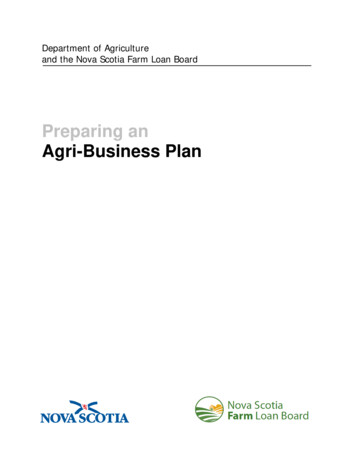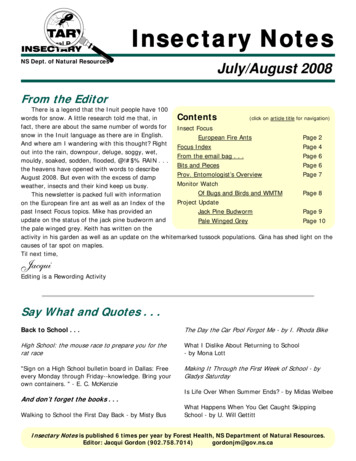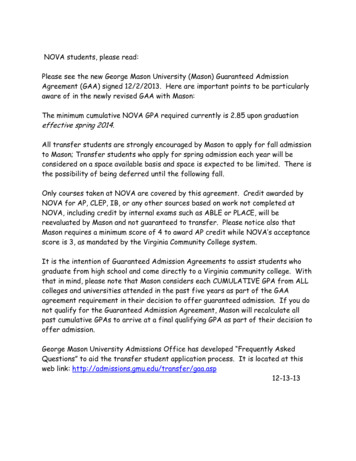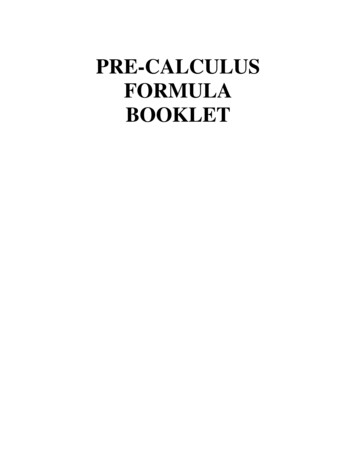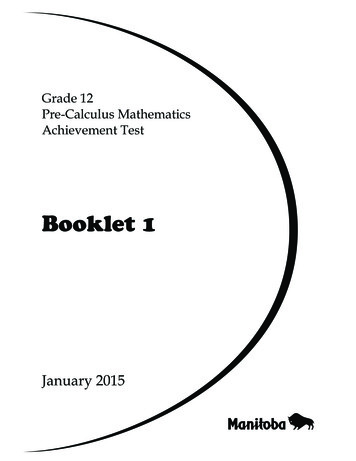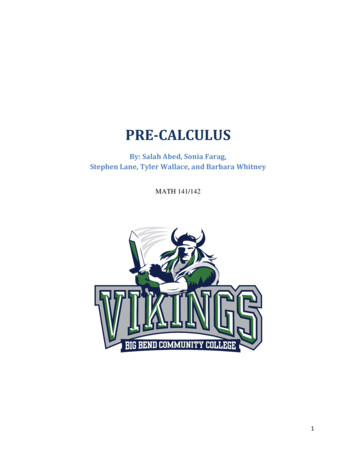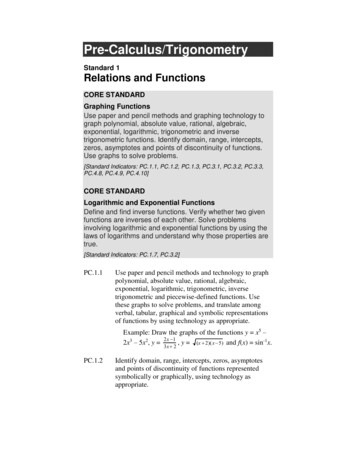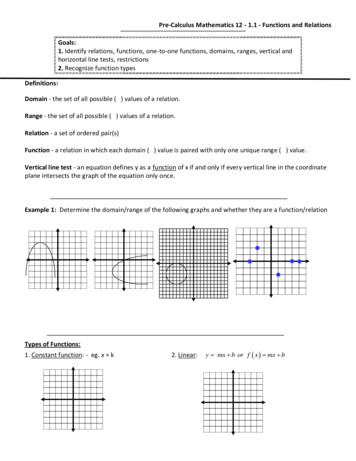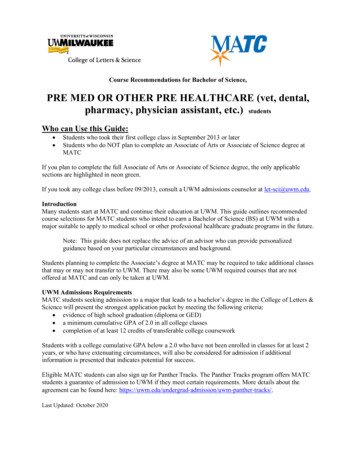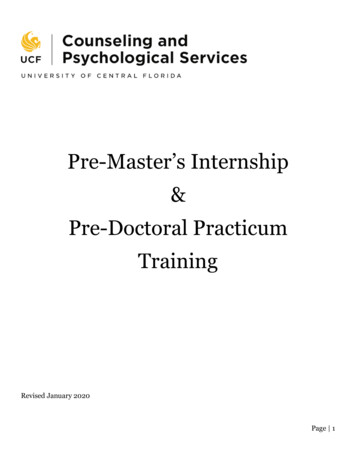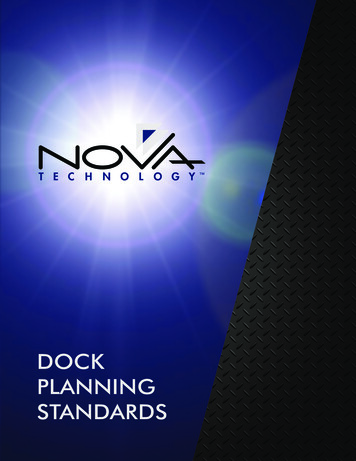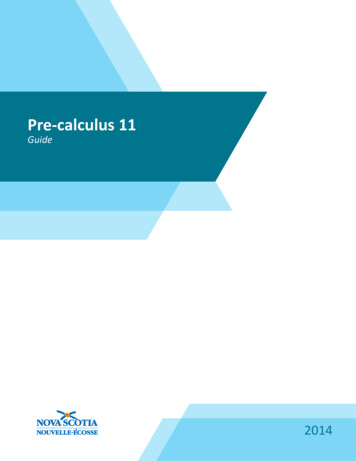
Transcription
Pre-calculus 11Guide2014
Website ReferencesWebsite references contained within this document are provided solely as a convenience and do not constitutean endorsement by the Department of Education of the content, policies, or products of the referenced website.The department does not control the referenced websites and subsequent links, and is not responsible for theaccuracy, legality, or content of those websites. Referenced website content may change without notice.Regional Education Centres and educators are required under the Department’s Public School ProgramsNetwork Access and Use Policy to preview and evaluate sites before recommending them for student use. If anoutdated or inappropriate site is found, please report it to curriculum@novascotia.ca .Pre-calculus 11 Crown copyright, Province of Nova Scotia, 2014, 2019Prepared by the Department of Education and Early Childhood DevelopmentThis is the most recent version of the current curriculum materials as used by teachers in Nova Scotia.The contents of this publication may be reproduced in part provided the intended use is for noncommercial purposes and full acknowledgment is given to the Nova Scotia Department of Education.
FT DFT DRACURRICULUM GUIDEArts Education Business Education English Language Arts Entrepreneurship Family Studies Health Education International Baccalaureate Languages Mathematics Personal Development and Career Education Physical Education Sciences Skilled Trades Social Studies Technology Education Information and Communication Technology Arts Education Business EducationEnglish Language Arts Entrepreneurship Family Studies Health Education International Baccalaureate Languages Mathematics Personal Development and Career Education Physical Education Sciences Skilled Trades Social Studies Technology Education Information and Communication Technology Arts Education Business Education English Language Arts EntrepreneurshipFamily Studies Health Education International Baccalaureate Languages Mathematics Personal Development and Career Education Physical Education Sciences Skilled Trades Social Studies Technology Education Information and Communication Technology Arts Education Business Education English Language Arts Entrepreneurship Family Studies Health EducationInternational Baccalaureate Languages Mathematics Personal Development and Career Education Physical Education Sciences Skilled Trades Social Studies Technology Education Information and Communication Technology Arts Education Business Education English Language Arts Entrepreneurship Family Studies Health Education International Baccalaureate LanguagesMathematics Personal Development and Career Education Physical Education Sciences Skilled Trades Social Studies Technology Education Information and Communication Technology Arts Education Business Education English Language Arts Entrepreneurship Family Studies Health Education International Baccalaureate Languages Mathematics Personal Developmentand Career Education Physical Education Sciences Skilled Trades Social Studies Technology Education Information and Communication Technology Arts Education Business Education English Language Arts Entrepreneurship Family Studies Health Education International Baccalaureate Languages Mathematics Personal Development and Career Education PhysicalEducation Sciences Skilled Trades Social Studies Technology Education Information and Communication Technology Arts Education Business Education English Language Arts Entrepreneurship Family Studies Health Education International Baccalaureate Languages Mathematics Personal Development and Career Education Physical Education Sciences Skilled TradesSocial Studies Technology Education Information and Communication Technology Arts Education Business Education English Language Arts Entrepreneurship Family Studies Health Education International Baccalaureate Languages Mathematics Personal Development and Career Education Physical Education Sciences Skilled Trades Social Studies Technology EducationInformation and Communication Technology Arts Education Business Education English Language Arts Entrepreneurship Family Studies Health Education International Baccalaureate Languages Mathematics Personal Development and Career Education Physical Education Sciences Skilled Trades Social Studies Technology Education Information and CommunicationTechnology Arts Education Business Education English Language Arts Entrepreneurship Family Studies Health Education International Baccalaureate Languages Mathematics Personal Development and Career Education Physical Education Sciences Skilled Trades Social Studies Technology Education Information and Communication Technology Arts Education BusinessEducation English Language Arts Entrepreneurship Family Studies Health Education International Baccalaureate Languages Mathematics Personal Development and Career Education Physical Education Sciences Skilled Trades Social Studies Technology Education Information and Communication Technology Arts Education Business Education English Language ArtsEntrepreneurship Family Studies Health Education International Baccalaureate Languages Mathematics Personal Development and Career Education Physical Education Sciences Skilled Trades Social Studies Technology Education Information and Communication Technology Arts Education Business Education English Language Arts Entrepreneurship Family StudiesHealth Education International Baccalaureate Languages Mathematics Personal Development and Career Education Physical Education Sciences Skilled Trades Social Studies Technology Education Information and Communication Technology Arts Education Business Education English Language Arts Entrepreneurship Family Studies Health Education InternationalBaccalaureate Languages Mathematics Personal Development and Career Education Physical Education Sciences Skilled Trades Social Studies Technology Education Information and Communication Technology Arts Education Business Education English Language Arts Entrepreneurship Family Studies Health Education International Baccalaureate Languages MathematicsPersonal Development and Career Education Physical Education Sciences Skilled Trades Social Studies Technology Education Information and Communication Technology Arts Education Business Education English Language Arts Entrepreneurship Family Studies Health Education International Baccalaureate Languages Mathematics Personal Development and CareerEducation Physical Education Sciences Skilled Trades Social Studies Technology Education Information and Communication Technology Arts Education Business Education English Language Arts Entrepreneurship Family Studies Health Education International Baccalaureate Languages Mathematics Personal Development and Career Education Physical Education SciencesSkilled Trades Social Studies Technology Education Information and Communication Technology Arts Education Business Education English Language Arts Entrepreneurship Family Studies Health Education International Baccalaureate Languages Mathematics Personal Development and Career Education Physical Education Sciences Skilled Trades Social StudiesTechnology Education Information and Communication Technology Arts Education Business Education English Language Arts Entrepreneurship Family Studies Health Education International Baccalaureate Languages Mathematics Personal Development and Career Education Physical Education Sciences Skilled Trades Social Studies Technology Education Informationand Communication Technology Arts Education Business Education English Language Arts Entrepreneurship Family Studies Health Education International Baccalaureate Languages Mathematics Personal Development and Career Education Physical Education Sciences Skilled Trades Social Studies Technology Education Information and Communication Technology ArtsEducation Business Education English Language Arts Entrepreneurship Family Studies Health Education International Baccalaureate Languages Mathematics Personal Development and Career Education Physical Education Sciences Skilled Trades Social Studies Technology Education Information and Communication Technology Arts Education Business Education EnglishLanguage Arts Entrepreneurship Family Studies Health Education International Baccalaureate Languages Mathematics Personal Development and Career Education Physical Education Sciences Skilled Trades Social Studies Technology Education Information and Communication Technology Arts Education Business Education English Language Arts EntrepreneurshipPre-calculus 11DRAFTrobetcO 0142RA
Pre-calculus 11Implementation DraftSeptember 2014
Website ReferencesWebsite references contained within this document are provided solely as a convenience and do notconstitute an endorsement by the Department of Education and Early Childhood Development of thecontent, policies, or products of the referenced website. The Department does not control thereferenced websites and subsequent links, and is not responsible for the accuracy, legality, or contentof those websites. Referenced website content may change without notice.School boards and educators are required under the Department’s Public School Network Access andUse Policy to preview and evaluate sites before recommending them for student use. If an outdatedor inappropriate site is found, please report it to links@EDnet.ns.ca.Pre-calculus 11, Implementation Draft, September 2014 Crown copyright, Province of Nova Scotia 2014Prepared by the Department of Education and Early Childhood DevelopmentThe contents of this publication may be reproduced in part provided the intended use is for noncommercial purposes and full acknowledgment is given to the Nova Scotia Department of Education andEarly Childhood Development. Where this document indicates a specific copyright holder, permission toreproduce the material must be obtained directly from that copyright holder. Please note that allattempts have been made to identify and acknowledge information from external sources. In the eventthat a source was overlooked, please contact English Program Services, Nova Scotia Department ofEducation and Early Childhood Development, eps@EDnet.ns.ca.Cataloguing-in-Publication Data
AcknowledgementsAcknowledgementsThe Nova Scotia Department of Education and Early Childhood Education wishes to express its gratitudeto the following organizations for granting permission to adapt their mathematics curriculum in thedevelopment of this guide.The Western and Northern Canadian Protocol(WNCP) for Collaboration in EducationPrince Edward Island Department of Educationand Early Childhood DevelopmentNewfoundland and Labrador Department ofEducationThe New Brunswick High School MathematicsCurriculum Development Advisory CommitteeWe also gratefully acknowledge the contributions of the following individuals toward the developmentof the Nova Scotia Pre-calculus 11 curriculum.Arlene Andreyck (Retired)Cape Breton Victoria Regional School BoardMark MacLeodSouth Shore Regional School BoardDarryl BreenStrait Regional School BoardSonya O’SullivanHalifax Regional School BoardJennifer CourishChignecto Central Regional School BoardMark PettipasStrait Regional School BoardBob CraneMi'kmaw Kina'matneweyLynn Evans PhillipsSouth Shore Regional School BoardDarlene MacKeen HudsonChignecto Central Regional School BoardAnna SpanikHalifax Regional School BoardAnne KellyHalifax Regional School BoardMarlene UrquhartCape-Breton Victoria Regional School BoardPatsy Height Lewis (Retired)Tri-County Regional School BoardTom WillisTri-County Regional School BoardPre-calculus 11, Implementation Draft, September 2014iii
ContentsContentsIntroduction . 1Background and Rationale . 1Purpose. 1Program Design and Components . 3Pathways . 3Assessment . 5Outcomes . 7Conceptual Framework for Mathematics 10–12 . 7Structure of the Pre-calculus 11 Curriculum . 7Outcomes and Performance Indicators . 8Mathematical Processes. 16Nature of Mathematics . 22Curriculum Document Format. 24Contexts for Learning and Teaching . 27Beliefs about Students and Mathematics Learning . 27UnitsAlgebra and Number . 33Trigonometry . 95Relations and Functions . 119References . 247Pre-calculus 11, Implementation Draft, September 2014v
IntroductionIntroductionBackground and RationaleMathematics curriculum is shaped by a vision that fosters the development of mathematically literatestudents who can extend and apply their learning and who are effective participants in society. It isessential that the mathematics curriculum reflect current research in mathematics instruction. Toachieve this goal, Western and Northern Canadian Protocol’s (WNCP) The Common CurriculumFramework for Grades 10–12 Mathematics (2008) has been adopted as the basis for the newmathematics curriculum in Nova Scotia.The Common Curriculum Framework was developed by the seven ministries of education (Alberta,British Columbia, Manitoba, Northwest Territories, Nunavut, Saskatchewan, and Yukon Territory) incollaboration with teachers, administrators, parents, business representatives, post-secondaryeducators, and others. The framework identifies beliefs about mathematics, general and specific studentoutcomes, and performance indicators agreed upon by the seven jurisdictions. The outcomes andperformance indicators have been adapted for Nova Scotia. This document is based on both nationaland international research by the WNCP and the National Council of Teachers of Mathematics (NCTM).There is an emphasis in the Nova Scotia curriculum on particular key concepts at each grade that willresult in greater depth of understanding and, ultimately, stronger student achievement. There is also agreater emphasis on number sense and operations concepts in the early grades to ensure studentsdevelop a solid foundation in numeracy.PurposeThis document provides sets of outcomes and performance indicators to be used as a mandatedcommon base for defining mathematics curriculum expectations. This common base should result inconsistent student outcomes in mathematics within the province of Nova Scotia. It should also enableeasier transfer for students moving within the province or from any jurisdiction that has adopted theWNCP framework. This document is intended to clearly communicate to all education partners acrossthe province the high expectations for students’ mathematical learning.Mathematics at Work 11, Implementation Draft, September 20141
Program Design and ComponentsProgram Design and ComponentsPathwaysThe Common Curriculum Framework for Grades 10–12 Mathematics (WNCP 2008), on which the NovaScotia Mathematics 10–12 curriculum is based, includes pathways and topics rather than strands as inThe Common Curriculum Framework for K–9 Mathematics (WNCP 2006). In Nova Scotia, four pathwaysare available: Mathematics Essentials, Mathematics at Work, Mathematics, and Pre-calculus.Each topic area requires that students develop a conceptual knowledge base and skill set that will beuseful to whatever pathway they have chosen. The topics covered within a pathway are meant to buildupon previous knowledge and to progress from simple to more complex conceptual understandings.Goals of PathwaysThe goals of all four pathways are to provide prerequisite attitudes, knowledge, skills, andunderstandings for specific post-secondary programs or direct entry into the work force. All fourpathways provide students with mathematical understandings and critical-thinking skills. It is the choiceof topics through which those understandings and skills are developed that varies among pathways.When choosing a pathway, students should consider their interests, both current and future. Students,parents, and educators are encouraged to research the admission requirements for post-secondaryprograms of study as they vary by institution and by year.Design of PathwaysEach pathway is designed to provide students with the mathematical understandings, rigour, andcritical-thinking skills that have been identified for specific post-secondary programs of study and fordirect entry into the work force.The content of the Mathematics Essentials courses was designed in Nova Scotia to fill a specific need forNova Scotia students. The content of each of the Mathematics at Work, Mathematics, and Pre-calculuspathways has been based on the Western and Northern Canadian Protocol (WNCP) Consultation withPost-Secondary Institutions, Business and Industry Regarding Their Requirements for High SchoolMathematics: Final Report on Findings (Alberta Education 2006) and on consultations with mathematicsteachers.MATHEMATICS ESSENTIALS (GRADUATION)This pathway is designed to provide students with the development of the skills and understandingsrequired in the workplace, as well as those required for everyday life at home and in the community.Students will become better equipped to deal with mathematics in the real world and will become moreconfident in their mathematical abilities.Pre-calculus 11, Implementation Draft, September 20143
Program Design and ComponentsMATHEMATICS AT WORK (GRADUATION)This pathway is designed to provide students with the mathematical understandings and critical-thinkingskills identified for entry into some college programs and for direct entry into the work force. Topicsinclude financial mathematics, algebra, geometry, measurement, number, and statistics and probability.MATHEMATICS (ACADEMIC)This pathway is designed to provide students with the mathematical understandings and critical-thinkingskills identified for post-secondary studies in programs that require an academic or pre-calculusmathematics credit. Topics include financial mathematics, geometry, measurement, number, logicalreasoning, relations and functions, and statistics and probability. Note: After completion of Mathematics11, students have the choice of an academic or pre-calculus pathway.PRE-CALCULUS (ADVANCED)This pathway is designed to provide students with the mathematical understandings and critical-thinkingskills identified for entry into post-secondary programs that require the study of theoretical calculus.Topics include algebra and number, measurement, relations and functions, trigonometry, andpermutations, combinations, and binomial theorem.Pathways and CoursesThe graphic below summarizes the pathways and courses offered.4Pre-calculus 11, Implementation Draft, September 2014
Program Design and ComponentsInstructional FocusEach pathway in senior high mathematics pathways is arranged by topics. Students should be engagedin making connections among concepts both within and across topics to make mathematical learningexperiences meaningful.Teachers should consider the following points when planning for instruction and assessment. The mathematical processes that are identified with the outcome are intended to help teachersselect effective pedagogical approaches for the teaching and learning of the outcome.All seven mathematical processes must be integrated throughout teaching and learning approachesand should support the intent of the outcomes.Wherever possible, meaningful contexts should be used in examples, problems, and projects.Instruction should flow from simple to complex and from concrete to abstract.The assessment plan for the course should be a balance of assessment for learning and assessmentof learning.The focus of student learning should be on developing a conceptual and procedural understanding ofmathematics. Students’ conceptual understanding and procedural understanding must be directlyrelated.AssessmentOngoing assessment for learning is essential to effective teaching and learning. Research has shown thatassessment for learning (formative assessment) practices produce significant and often substantiallearning gains, close achievement gaps, and build students’ ability to learn new skills (Black & Wiliam1998; OECD 2006). Student involvement in assessment promotes learning. Timely and effective teacherfeedback and student self-assessment allow students to reflect on and articulate their understanding ofmathematical concepts and ideas.Assessment in the classroom includes providing clear goals, targets, and learning outcomes using exemplars, rubrics, and models to help clarify outcomes and identify important features of thework monitoring progress towards outcomes and providing feedback as necessary encouraging self-assessment fostering a classroom environment where conversations about learning take place, where studentscan check their thinking and performance and develop a deeper understanding of their learning(Davies 2000)Assessment for learning practices act as the scaffolding for learning, which only then can be measuredthrough assessment of learning (summative assessment). Assessment of learning tracks studentprogress, informs instructional programming, and aids in decision making. Both forms of assessment arenecessary to guide teaching, stimulate learning, and produce achievement gains.Pre-calculus 11, Implementation Draft, September 20145
Program Design and ComponentsAssessment of student learning should align with curriculum outcomes clearly define criteria for success make explicit the expectations for students’ performance use a wide variety of assessment strategies and tools yield useful information to inform instruction6Pre-calculus 11, Implementation Draft, September 2014
OutcomesOutcomesConceptual Framework for Mathematics 10–12The chart below provides an overview of how mathematical processes and the nature of mathematicsinfluence learning outcomes.(Adapted with permission from Western and Northern Canadian Protocol, The Common CurriculumFramework for K–9 Mathematics, p. 5. All rights reserved.)Structure of the Pre-calculus 11 CurriculumUnitsPre-calculus 11 comprises three units: Algebra and Number (AN) (30–35 hours) Trigonometry (T) (10 hours) Relations and Functions (RF) (60–70 hours)Pre-calculus 11, Implementation Draft, September 20147
OutcomesOutcomes and Performance IndicatorsThe Nova Scotia curriculum is stated in terms of general curriculum outcomes, specific curriculumoutcomes, and performance indicators.General Curriculum Outcomes (GCOs)General curriculum outcomes are overarching statements about what students are expected to learn ineach strand/sub-strand. The GCO for each strand/sub-strand is the same throughout the pathway.Algebra and Number (AN)Students will be expected to develop algebraic reasoning and number sense.Trigonometry (T)Students will be expected to develop trigonometric reasoning.Relations and Functions (RF)Students will be expected to develop algebraic and graphical reasoning through the study of relations.8Pre-calculus 11, Implementation Draft, September 2014
OutcomesSpecific Curriculum Outcomes (SCOs) and Performance IndicatorsSpecific curriculum outcomes are statements that identify specific concepts and related skillsunderpinned by the understanding and knowledge attained by students as expected for a given grade.Performance indicators are samples of how students may demonstrate their performance of the goals ofa specific curriculum outcome. The range of samples provided is meant to reflect the scope of the SCO.In the SCOs, the word including indicates that any ensuing items must be addressed to fully achieve thelearning outcome. The phrase such as indicates that the ensuing items are provided for clarification onlyand are not requirements that must be addressed to fully achieve the learning outcome. The word andused in an outcome indicates that both ideas must be addressed to achieve the learning outcome,although not necessarily at the same time or in the same question.ALGEBRA AND NUMBER (AN)AN01 Students will be expected to demonstrate an understanding of the absolute value of realnumbers.Performance IndicatorsAN01.01 Determine the distance of two real numbers of the form a , a R , from 0 on a number line,and relate this to the absolute value of a( a ) .AN01.02 Determine the absolute value of a positive or negative real number.AN01.03 Explain, using examples, how distance between two points on a number line can be expressedin terms of absolute value.AN01.04 Determine the absolute value of a numerical expression.AN01.05 Compare and order the absolute values of real numbers in a given set.AN02 Students will be expected to solve problems that involve operations on radicals and radicalexpressions with numerical and variable radicands.Performance IndicatorsAN02.01 Compare and order radical expressions with numerical radicands in a given set.AN02.02 Express an entire radical with a numerical radicand as a mixed radical.AN02.03 Express a mixed radical with a numerical radicand as an entire radical.AN02.04 Perform one or more operations to simplify radical expressions with numerical or variableradicands.AN02.05 Rationalize the denominator of a radical expression with monomial or binomial denominators.AN02.06 Describe the relationship between rationalizing a binomial denominator of a rationalexpression and the product of the factors of a difference of squares expression.AN02.07 Explain, using examples, that (–x)2 x2, x 2 x , and x 2 x .AN02.08 Identify the values of the variable for which a given radical expression is defined.AN02.09 Solve a problem that involves radical expressions.Pre-calculus 11, Implementation Draft, September 20149
OutcomesAN03 Students will be expected to solve problems that involve radical equations (limited to squareroots).Performance Indicators(It is intended that the equations will have no more than two radicals.)AN03.01 Determine any restrictions on values for the variable in a radical equation.AN03.02 Determine the roots of a radical equation algebraically, and explain the process used to solvethe equation.AN03.03 Verify, by substitution, that the values determined in solving a radical equation algebraicallyare roots of the equation.AN03.04 Explain why some roots determined in solving a radical equation algebraically are extraneous.AN03.05 Solve problems by modelling a situation using a radical equation.AN04 Students will be expected to determine equivalent forms of rational expressions (limited tonumerators and denominators that are monomials, binomials, or trinomials).Performance IndicatorsAN04.01 Compare the strategies for writing equivalent forms of rational expressions to the strategiesfor writing equivalent forms of rational numbers.AN04.02 Explain why a given value is non-permissible for a given rational expression.AN04.03 Determine the non-permissible values for a rational expression.AN04.04 Determine a rational expression that is equivalent to a given rational expression by multiplyingthe numerator and denominator by the same factor (limited to a monomial or a binomial),and state the non-permissible values of the equivalent rational expression.AN04.05 Simplify a rational expression.AN04.06 Explain why the non-permissible values of a given rational expression and its simplified formare the same.AN04.07 Identify and correct errors in a simplification of a rational expression, and explain thereasoning.AN05 Students will be expected to perform operations on rational expressions (limited to numeratorsand denominators that are monomials, binomials, or trinomials).Performance IndicatorsAN05.01 Compare the strategies for performing a given operation on rational expressions to thestrategies for performing the same operation on rational numbers.AN05.02 Determine the non-permissible values when performing operations on rational expressions.AN05.03 Determine, in simplified form, the sum or difference of rational expressions with the samedenominator.AN05.04 Dete
Pre-calculus 11, Implementation Draft, September 2014 3 : Program Design and Components : Pathways : The : Common Curriculum Framework for Grades 10–12 Mathematics (WNCP 2008), on which the Nova Scotia Mathematics 10 –12 curriculum is based,
